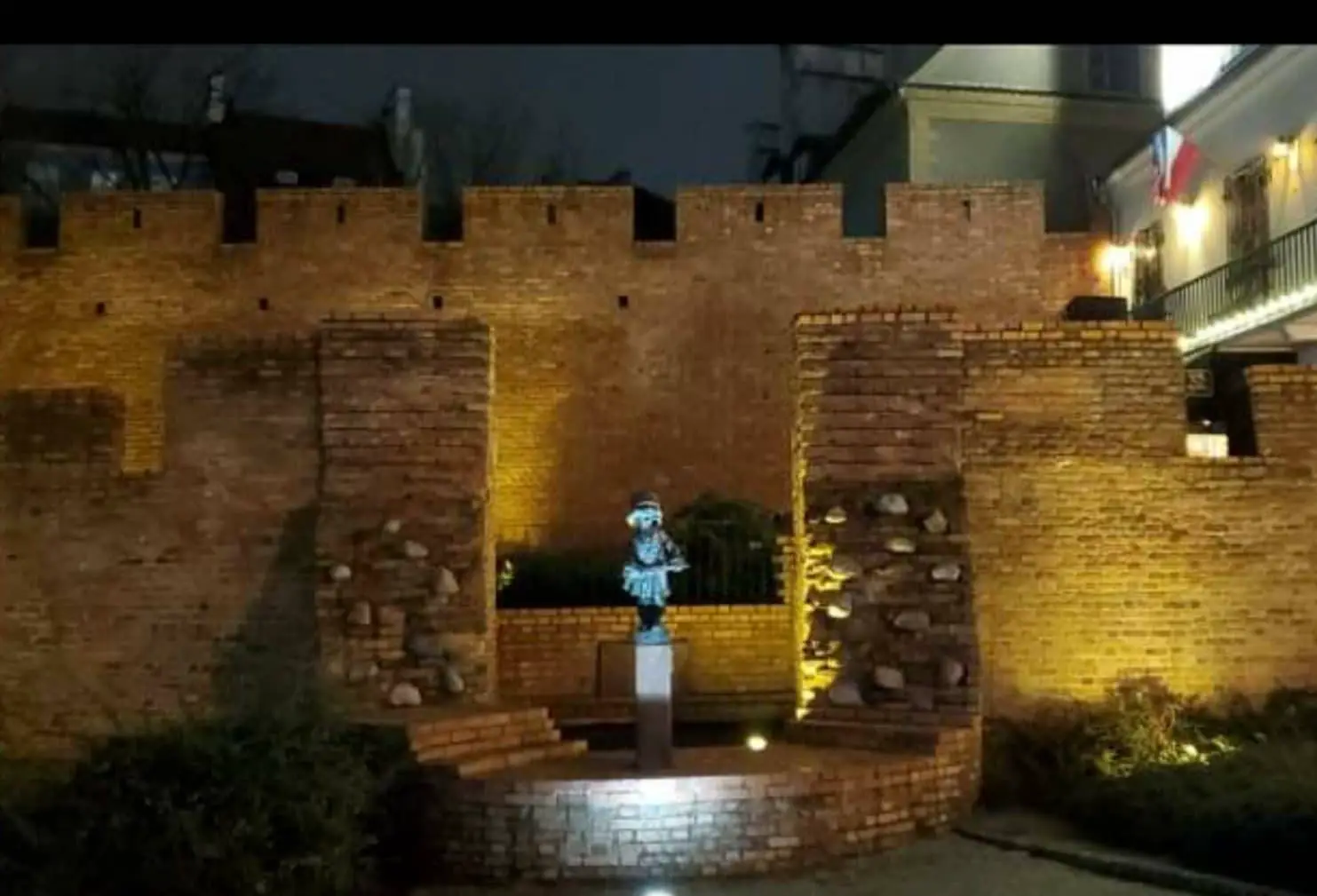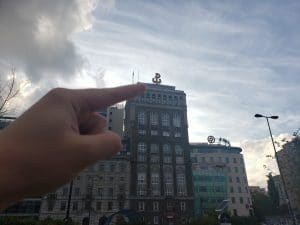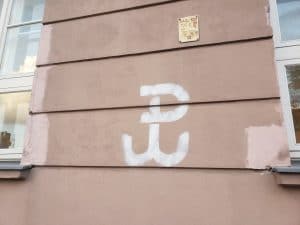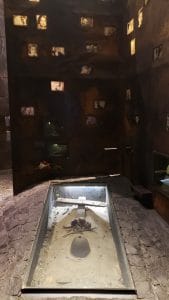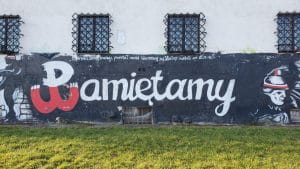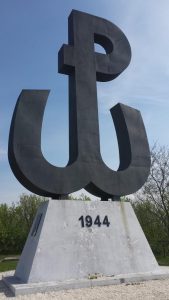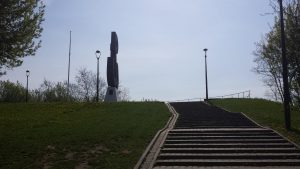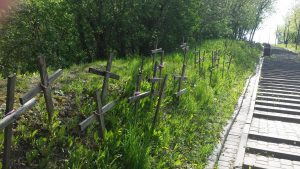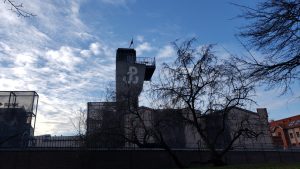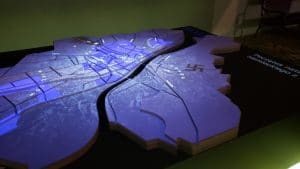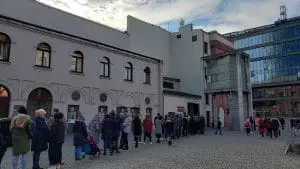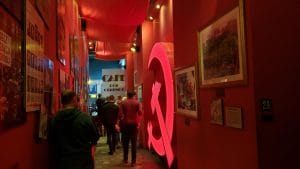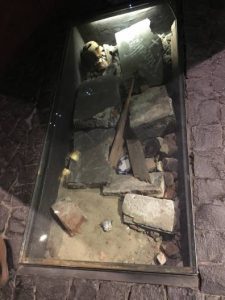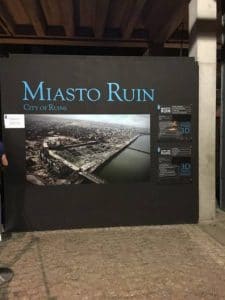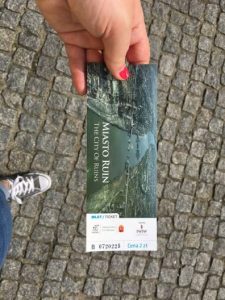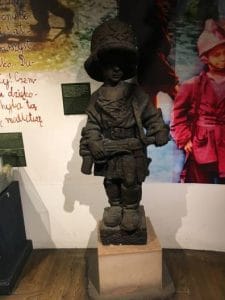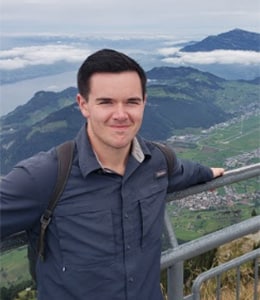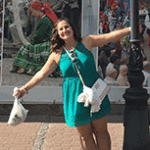Many of our students are profoundly moved by how vividly the Warsaw Uprising is remembered in Poland. Those who fought are revered with the respect of founding fathers. Thier symbols and history are preserved and highlighted across the city in museums, monuments, and graffitti. The narrative is popular in modern film (such as the recent Warsaw ’44, among many others) and video games. Below are some thoughts and experiences related to the Warsaw Uprising that SRAS students have had while studying abroad in Warsaw.
History of the Warsaw Uprising
The history of the Warsaw Uprising is one of suffering and sacrifice; one that is too often overlooked in history courses covering the Second World War.
Warsaw first fell under Nazi control when, in 1939, the Nazis and Soviet Union invaded Poland and split it under the Molotov – Ribbentrop Pact, a secret non-aggression pact that took Poland off the map during World War II and divided it in half between Nazi and Soviet occupation.
In secret, an underground Polish army based in Warsaw amassed supplies, arms, and resistance fighters. They carried out various acts of sabotage against the Germans throughout the war, but managed to stay undercover. The time for a final push against the Nazis, the leaders felt, came with the landing of allied forces in France and a massive push by the Soviets that brought the eastern front line to the Vistula River, which divides Warsaw in two. The Polish resistance, by then about 400,000 strong, strategized that with their uprising, the Soviets would cross the river and aid in pushing the Nazis out of the city.
The Warsaw Uprising began on August 1, 1944. However, fewer than 50,000 members had proper weapons, and, it seems there was some confusion as to when the uprising should start that day. The resistance did take several important targets, including some weapons depots and the power station. However, the resistance units were not able to take enough territory to link up and take the most important Nazi-held strongholds like the city’s airport, railyard, and police station. Worse, the Soviet army never received the order to cross the river. The Soviets were concentrating forces elsewhere and argued that it was not yet the strategically right time to move to the other side of the river. However, to this day, many Poles believe that that Soviets held back to let the Germans be maximally weakened, the resistance crushed, and then to take over Warsaw and take full credit for the liberation so as to not feel compelled to share power with the independent resistance.
After a month or so of intense street fighting, Hitler declared that the city of Warsaw would be wiped from the map. The Nazis went door to door and executed anyone inside: men, women, and children in what would be known as the Wola Massacre, it is one of the many atrocities committed by the Nazis in Poland during World War II. In the face of this psychological warfare, the Polish resistance army surrendered. Most members were sent to POW camps or executed. The remaining Polish citizens in Warsaw (about 500,000 out of the 1.3 million that the city had begun the war with) were forcibly removed to the countryside. The Nazis then systematically went building by building burning, blowing up, and otherwise carrying out Hitler’s order to end the city’s existence.
In the end, 85% of the city of Warsaw, including nearly everything on the Western bank of the Vistula, was left in rubble. Further, 40,000 Polish resistance fighters were either killed or wounded, and 150,000 Polish civilians were killed in the Warsaw Uprising. The city remained essentially abandoned for four months until, in January, 1944, the Soviets finally invaded what was left of Warsaw. While the Soviets would rebuild Warsaw, restoring it beautifully and practically brick-by-brick as part of their efforts to win the hearts and minds of the Poles, the fact that it had taken the Soviets so long to make their advance has remained a historical sore point in the relations between the two nations.
Section by Eric Nesbit
The Warsaw Uprising In Modern Polish Culture
The history, hardship, and significance of the Warsaw Uprising is one of the most important and moving pieces of history for Warsaw and Poland. While I was on study abroad in Warsaw, one of the things I picked up on quite quickly was how important locals feel about the Warsaw Uprising. Within my first week of classes I met Polish students who explained its significance and how important it is to them personally.
I saw how Independence Day (November 11) is marked in Warsaw, which includes commemorating the uprising with small red candles lit up at key sites of the uprising. In addition, the symbol of the uprising is displayed on buildings, walls, and flags, and individuals wear pins and arm bands.
I made it a priority to learn as much as possible about the Warsaw Uprising while abroad in Poland. In this article I will walk through the history of the Warsaw Uprising, what a visit to the Uprising Museum in Warsaw is like, and explain the significance of the uprising today.
The Warsaw Uprising remains very prominent in Polish cultural memory. One of my close friends in Warsaw who studies at Collegium Civitas explained his personal connection to the uprising. His grandfather lived, suffered, and miraculously made it through the Second World War while living in Warsaw. He saw and experienced it all: the initial invasion, the terror bombing, the Warsaw Ghetto Uprising (a separate Jewish revolt in Spring of 1943), the Warsaw Uprising, and finally liberation. I was speechless hearing him retell his grandfather’s stories.
The Warsaw Uprising and also resistance against the Nazis in WWII also continues to be prominent in media and culture. For example, the uprising features prominently in the modern Polish films Warsaw 1944 (2014), Warsaw Uprising (2014), Baczynski (2013), and Uprising (2001). The international film The Pianist (2002) was also shot with Polish support and shows what happened to Warsaw at that time, although it focuses much more on the earlier Warsaw Ghetto Uprising.
There is also a Polish-produced video game, released in October 2019, called WARSAW that lets the player control a band of resistance fighters starting on August 1, 1944, the exact date of the uprising. It incorporates accurate maps, historical documents, and resistance missions that actually occurred to paint a picture of what the uprising was like and to immerse modern players in the history, making them feel like they are a part of it.
Section by Eric Nesbit
Resistance Monuments in Warsaw
Finally, there are many highly visible monuments around Warsaw that commemorate the heroic actions of resistance fighters and everyday Poles during the uprising. One is the massive Warsaw Uprising monument located in Krasinski Square near Old Town. Completed in 1989 by Wincenty Kucma and Jacek Budyn, it depicts two scenes from the Warsaw Uprising. The first is the initial attack showing resistance fighters using anything they have to attack the Nazis, and the other scene shows the resistance defeated and retreating through the sewer system. The sheer size of this monument speaks volume to the viewer, with the height of the soldiers being around ten meters (33 feet). The message that was conveyed to me from these large figures and this monument is the actions of individuals are far greater than the outcome. The Warsaw Uprising was not a success, but that does not diminish the heroic actions taken by the Polish civilians and resistance fighters in the Uprising.
Another monument is the statue of the Little Insurrectionist located just outside the Old Town wall. This statue of a small boy wearing oversized military fatigues, military helmet, and holding a submachine gun is to honor and remember the children of Warsaw who fought in the uprising. Both monuments are very moving and definitely worth visiting while in Warsaw.
As a student from the United States, I had very little knowledge about the Warsaw Uprising. In learning about it though, through interactions with Poles and by seeing the highly visible cultural memory of the events in modern Warsaw, my understanding has deepened and my respect grown. Although I had studied World War II, the Holocaust, and the Cold War, before these had only been events I studied in history classes. I knew they happened, but actually being in the places where these events took place and learning from the local culture and individuals in Warsaw has added a whole new level to my understanding. I can see these things more clearly as human events that affected and still affect real people. It has increased my empathy for those that lived through these times; the effects of which are still seen today.
Section by Eric Nesbit
Exploring the The Warsaw Uprising Mound
At the end of the street where Bartycka forms a “T” intersection with Czerniakowska Street, there is a small hilly park that (unbeknownst to me at the time) is quite historically significant.
Known since 2004 as Park “Akcji Burza” or “Operation Tempest,” the park stood at the edge of the city long forgotten and was only “rediscovered” in 1994 and then again in 2004. In the center of the park is a hill (one of the tallest in Warsaw) that was constructed from the literal rubble of the city after the Warsaw Uprising in 1944 and the subsequent complete destruction of the city by the Nazis. Long a heap of rubble, brick, and pieces of houses, it has slowly been overgrown with plants and trees since WWII. As late as 1995 maps of Warsaw that mentioned the hill described it as “Góra Śmieci” or “mountain of trash.”
It was only in 1994 that the significance of the place was rediscovered as a result of the tireless lobbying of the worldwide association of former Polish Home Army Soldiers, who (after the fall of Communism) began to fight for a monument to commemorate their work in liberating Warsaw in WWII. A monument in the shape of the Home Army’s symbol (the “Kotwica” or Anchor) was promised by the city to honor the veterans and heroes. The monument was scheduled to be ceremoniously opened on the 1st of August 1994 on the 50th Anniversary of the Warsaw Uprising. Due to monetary constraints at the time, however, the opening of the monument had to be slightly delayed and monument could only be affordably constructed of a few sheets of steel and concrete.
Then after the 50th anniversary celebrations, the hill fell once again into disuse and abandonment. The only way up the monument was a winding dirt path through the forest that spiraled up the hill. In 2004, in preparation for the 60th Anniversary celebrations of the Warsaw Uprising, the city decided to rename the hill as “Kopiec Powstania Warszawskiego” or the “Mound of the Warsaw Uprising” and renovate the monument (Uchwałą nr XXVII/513/2004 Rady miasta stołecznego Warszawy or Resolution Number XXVII/513/2004 of the Warsaw City Council). The city built and paved a direct path up the mound to the monument, which is actually the longest staircase in Warsaw today at 250 meters with 400 steps. The new route was even given a street name, “Godzina ‘W’” (hour of the “Wybuch” or explosion, the code name referring to 17.00 on 01.09.1944 when the Warsaw Uprising began) and the street was lined with wooden crosses and Polish flags.
When I visited the park, I was struck by how easy it was to pass this historic site by (as I had so many times before) without realizing its significance. The park is fenced in and the entrance is a bit hidden behind a couple of construction supply stores and is far from obvious. The new path up the hill (ul. Godziny “W”) is noticeable enough but the older dirt path looks like it could lead anywhere or be one of the downhill biking trails that dot the mound. Indeed, I found it quite odd that this mound and monument to the Warsaw Uprising, however hidden and not well-known, is used by bikers as a downhill slope and that the practice is tolerated and even documented online.
In any case, on separate occasions, I have taken both paths and found them both interesting in their own ways. The direct path is lined with crosses, adorned with pieces of cloth in the colors of the Polish flag, and it takes a gentle slope that allows you to see your goal (the monument of the Home Army anchor) as you approach it. The winding, dirt path on the other hand, feels like you are alone in the midst of a forest and allows you to appreciate the ground (made of the city’s rubble) on which you’re standing. If you’re observant and lucky, you might even be able to find a piece of concrete or old brick protruding a bit from the earth.
When I finally reached the top, I was treated to a beautiful view of Warsaw and its skyline. The whole city was visible, although the north side of the city was obscured slightly behind some trees. The monument itself is huge, truly monumental and its base was even taller than me. I could tell that the monument was beginning to age once again, however, with the paint on its base chipping a bit. Although it had clearly not been maintained to same extent as other monuments in the city, it was apparent that some people still visited the site as someone had recently (within the past few days) laid flowers at the foot of the monument and they were just beginning to dry up. As I walked back down the steps to go home, I enjoyed the view of the city’s skyline once last time and left with a sense understanding for the site’s unique history. It had been no everyday walk in the park. If you’re in the area, Park “Akcji Burza” is worth checking out…but I wouldn’t recommend going out of your way to do so.
Section by Josh Seale
Warsaw Uprising Museum
That the Uprising can still be felt strongly in Poland as part of Polish identity can be seen at The Warsaw Uprising Museum.
Walking through Warsaw’s central business district, after passing rows of modern glass-and-steel structures, you’ll come across the perfectly restored and preserved former Tram Power Plant. A piece of classic turn-of-the-century industrial architecture, the plant was a hold out during the initial Nazi invasion. Eventually, however, the Nazis stormed the building and killed the workers who had protected the plant. It was again an important battle point during the Warsaw Uprising and taken by the resistance. Thus, it is a fitting location for the Warsaw Uprising Museum.
Admission is only 25 PLN ($6.36) and just 20 PLN ($5) with a student discount. Further, on Sundays, admission is free. Despite the low cost, the museum is not only in a beautifully restored and maintained building, but also offers audio guides (10 PLN, $2.50) developed in a long list of languages, and is full of ambitious, immersive displays including full-size replicas of the sewers famously used by the resistance fighters. This is made possible by the fact that the museum receives funding from the city of Warsaw as an important cultural institution. It is also made possible by its strikingly high attendance rates. The Uprising Museum is the second most visited museum in Warsaw, behind only the Copernicus Science Center, drawing people from all over Poland, Europe, and beyond. On Sundays, one can easily stand in line to enter for 45 minutes.
Upon entering the museum, the exhibits begin just after the coat check area and are led by easy-to-follow signs. All the exhibits in the museum include descriptions in both Polish and English. The museum has three display floors and, although showing a large collection of thousands of artifacts ranging from weapons, to furniture, to love letters, the museum does a great job telling its story in a narrative, interactive fashion. The artifacts are used to create memorable scenes and interactive displays, making sure that the focus is on the Uprising as a movement and event, rather than scattered over thousands of potentially forgettable details.
Going through the museum takes about two hours going at about an average pace, but you could easily spend double that time if you read and watched everything they have to offer. It is important to note, the Warsaw Uprising Museum is not exactly an uplifting place to visit. It depicts a brutal time in the history of Warsaw – one that was marked by death, oppression, and destruction. So when coming to the museum keep that in mind. Bring an empathetic mindset and be fully aware that the Polish museum goer next to you may have lost friends and family members in the Warsaw Uprising.
Section by Eric Nesbit
A Tour of the Warsaw Uprising Museum with SRAS
During a class taken as part of my Security and Society program through SRAS, a professor noted that the Poles were great at two things: “Uprising, and terribly failing at it.” Since the city of Warsaw is history everywhere you look, I decided to go to the Warsaw Rising Museum, one of Warsaw’s many great museums, to learn about the history I saw every day. The added bonus of free admission to everyone on Sundays made it even easier to want to go.
The museum wastes no space as the second you walk into the building the tour starts. With arrows pointing in the direction the time line follows, it is easy to understand where to start and then which way to head next. The museum first starts with the rise of the Nazi power and therefore the rise of the Polish Resistance Group. The museum does a fantastic job at representing all individuals that had any role whatsoever in the fight against any non-Polish power. In the beginning of the museum there is even a room dedicated to the children who helped the resistance. The room showed the various different jobs a child would have, the toys that the children would play with, and a movie of children in action showed continuously on the back wall.
The tour goes on to have a timeline of events from the very beginning of the Nazi Regime taking over Poland. Throughout the timeline, the wall offers explanations and pictures of the type of treatment the Poles received. The wall ends with the building of the Warsaw Ghetto, with pictures and memories written out with what life was like inside the ghetto walls.
As you follow the arrows to take an elevator upstairs, you are led to the part of the museum that describes the actual uprising. A whole room is dedicated to the makeshift military that was made, and continues though the history of the Polish Army to the present day. The best part of the museum was the 3D movie showing what the city looked like before, during, and after the War. It was shocking to the core to witness how much the city was torn down. It then gave me a deeper appreciation to see what it is today.
The history brought to life in this museum is fascinating, and I believe that the museum does a wonderful job at detailing the oppression that the Poles experienced. My only warning about this museum is that because it is free to the public on Sundays, it attracts crowds across the spectrum. This includes school-aged children that don’t necessarily respect or even have a desire to learn the history on display at this museum. The moment of silence I observed respectfully while walking by makeshift graves portraying the despair of a city in turmoil was interrupted by children running through the museum, screaming and yelling. It was shocking to see some children who appeared to have no interest in the horrific events that occurred in the history of their country. I couldn’t help but think that more reverence should be given to the heartbreaking events and the people that were involved. But then I realized that many children the world over have difficulty appreciating historical events, especially in the setting of a museum.
I highly suggest a visit to this museum. With my routine down, the museum gave me a day to realize that I am not just living in a different city, I am living in a whole different part of history. I appreciate this city and the culture so much more after my visit to this museum.
Section by Regan Bortz
More on the Warsaw Uprising and Polish History
- A History of Warsaw Poland (from GeoHistory.Today)
- Polish Holidays and Remembrances (From Folkways.Today)
- More Museums in Warsaw (on this site).


